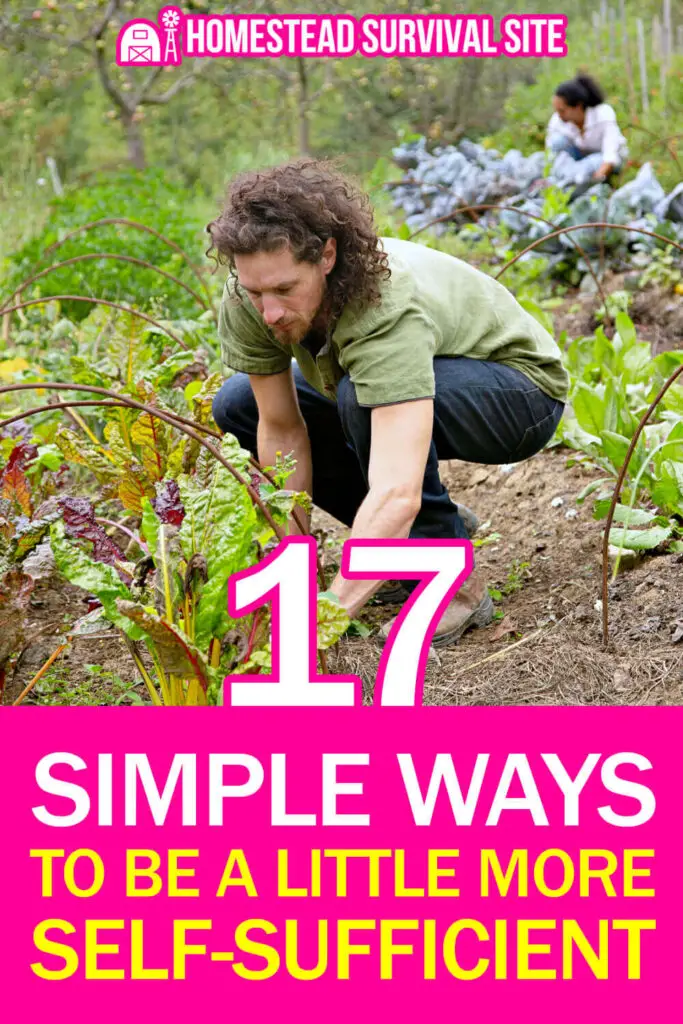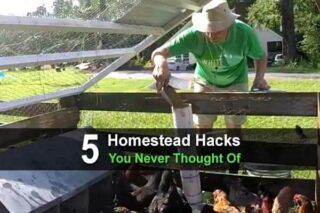Estimated reading time: 9 minutes
Pandemic. Economic crisis. Civil unrest. The extraordinary times in which we are living are causing more and more people to yearn for a simpler way of life. However, it can be daunting to consider all the changes that are part of adopting a self-sufficient lifestyle.
The good news is that you don't need to wait until you have that big savings account or that large piece of land to get started. You can begin your journey today. Here are 17 simple ways to be more self-sufficient, no matter where you are.
Want to save this post for later? Click Here to Pin It On Pinterest!
Food
1. Grow And Raise Your Own Food
You don't need acres of land to start growing your own food. You can grow fresh herbs on a sunny windowsill. Or grow tomatoes, cucumbers, lettuce, peppers, and berries in baskets on your porch or patio. Look for varieties that grow well in containers and consider adding some trellises to accommodate growth.
If you have a backyard, you can grow more fruits and vegetables. Make the most use of your space with raised beds, and think “up” with more trellises and with bushes and trees. You also can consider raising small livestock. For example, raising chickens can provide eggs for your family and can even turn into a side business if you have enough space.
2. Preserve Food
Another way to become more self-sufficient is by preserving food. You can save money and prepare for potential crises by storing food you grew yourself or bought in bulk at the store. The basic means of food preservation include freezing, canning, fermenting, dehydrating, curing, and cold cellaring.
The National Center for Home Food Preservation can get you started with some basic how-to's and recipes.
3. Prepare Meals From Scratch
Did you hear about the increase in the popularity of homemade bread during the pandemic? Baking and home cooking can be satisfying and even therapeutic.
You can expand upon this theme by making entire meals from scratch—and save money at the same time. It's also easy and inexpensive to make your own condiments such as salsa, soy sauce, and salad dressings.
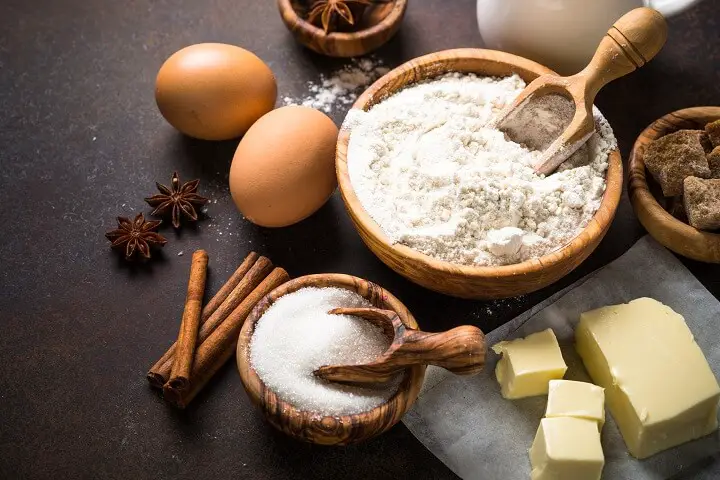
4. Forage
Searching outside for wild edibles takes a bit of know-how, but it can become a hobby that will greatly add to your self-sufficient lifestyle. Foraging also is an essential survival skill. Here is a beginner's guide to foraging.
5. Hunt And Fish
It's not for everybody, but another way to become more self-sufficient is to hunt and fish for your protein. Both activities are subject to state and local licenses, so be sure to check your local regulations.
6. Compost
Another easy way to become more self-sufficient is to make your own compost, nature's fertilizer. Although there are some things you should know before you start, it's fairly easy. Just don't try composting these things.
Water
7. Conserve Water
Whether you pay for municipal water or have your own well, saving water should be a priority of a self-sufficient lifestyle. Here are a few ways to conserve that precious commodity.
- Check your toilet, pipes, and faucets for leaks. (Even a little drip can waste 50 or more gallons of water each day.)
- Take shorter showers. (A shower can use up to 10 gallons of water a minute.)
- Install water-saving showerheads.
- Take more baths. (A partly-filled tub uses less water than most showers.)
- Don't keep water running while brushing your teeth.
- Turn off the water while shaving. (Before you begin shaving, add a few inches of warm water to the sink.)
- Only run a full dishwasher or washing machine.
- Rinse your vegetables in a bowl of clean water.
- Keep a bottle of water in the refrigerator for drinking rather than running the tap when you want cool water.
- Don't leave the water in the sink running for rinsing dishes. Use a second sink or a pan of water for the rinsing process.
- Deep-soak your lawn rather than light sprinkling more frequently. Water during the cooler times of the day.
- Plant drought-resistant plants and trees.
- Use a bucket of soapy water to clean your car. Use the hose only for rinsing.
8. Reuse Water
Collect grey water, which is leftover water from household sinks, bathtubs, or washing machines, to water your garden. Here are some ideas for reclaiming grey water.
- Place a bucket in the shower to catch water as it warms up and while you shower.
- Put a container under the sink faucet to collect cold water while waiting for it to heat up or cool down.
- Let the water you cooked pasta or veggies cool off, then use it to water your plants.
- When you give your pet fresh water, save the old water for outdoor use.
- Save leftover (cooled) coffee to pour on acid-loving plants.
9. Collect Rainwater
Place a barrel or a clean trash can where it can catch roof water run-off during a rainstorm. Of course, there's a little more to it than that. Here's how to harvest rainwater, and here are some mistakes to avoid.
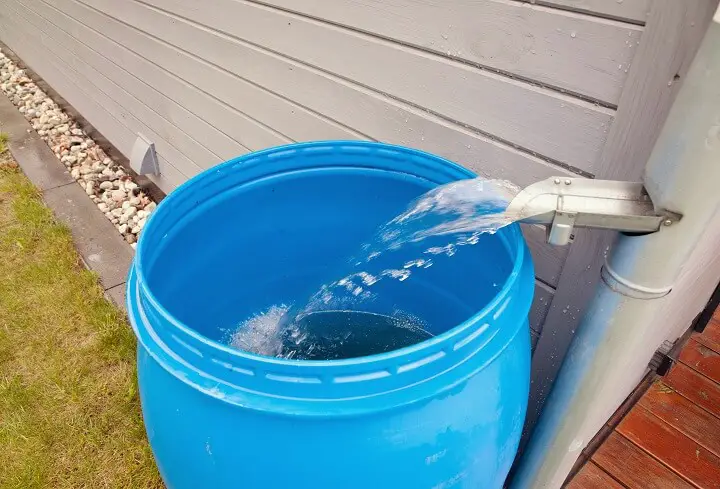
Energy
10. Install Solar Panels
Harnessing the sun's energy for most of your power needs might be a long-term goal for self-sufficiency. However, you can start small with solar panel kits which are ideal for powering small electronics, an outbuilding or cabin, or a driveway gate.
You can also help keep your home warmer in the winter and cooler in the summer by making simple window coverings. You can block the sun's rays in the summer heat with curtains and then open them to gain full advantage of the sun’s more limited warmth in the winter. Here are some more ideas.
11. Purchase a Generator
Having a home generator can give you peace of mind that you can keep essential things up and running during a power outage. You can find everything from small portable generators to machines that will power your whole house.
12. Reduce Energy Usage
No matter what your plans are for future homesteading or off-grid living, you can begin by cutting your energy footprint now. Here are some simple ways to save energy, even if you live in an apartment.
- Use energy-efficient light bulbs. Compact fluorescent lights, light-emitting diode bulbs, and halogen bulbs last 3 to 25 times longer and use anywhere from 30 to 80 percent less electricity than traditional bulbs.
- Turn off electronics when not in use. Smart power strips can make this an easy process and can save you up to $200 per year in energy bills.
- Upgrade your heating and cooling system and use a smart thermostat to regulate temperature when you are away.
- Use less hot water. Wash clothes in cold water, turn down the thermostat on your water heater, and insulate your water heater.
- Close up or seal any cracks and drafts in your home's doors and windows. When replacing windows, look for new energy-efficient styles.
Household
13. Waste Less Paper
Cut down or eliminate your use of paper towels and paper napkins by making cloth napkins and cleaning rags out of old clothing and linens. You’ll find that they work better, and you’ll appreciate the savings.
14. Reduce Dryer Usage by Air-Drying Your Clothes
Install clothes lines outdoors or in the basement and use drying racks in your laundry room. In addition to saving energy, air-drying is easier on your clothing and helps prevent annoying static cling.
15. Make Your Own All-Natural Cleaners
With just as few basic products, such as baking soda, white vinegar, lemon, you can make homemade safe and effective cleaning solutions.
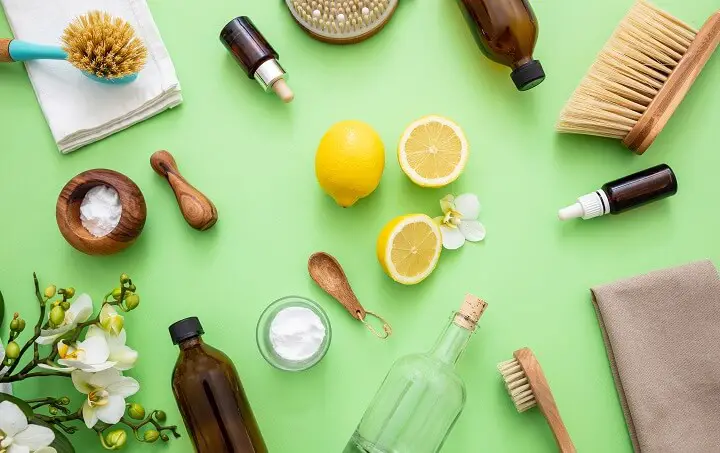
16. Start A Home Business
You don't need to quit your day job before you launch a side gig. But having your own business is a big step toward self-sufficiency. Think of the things you can do and services you can offer and then brainstorm ways you can turn those talents or interests into a money-making endeavor.
For example, you could sell anything from homemade soap to homegrown veggies. Or you could market a service, such as tutoring or consulting.
17. Cut Back On Unnecessary Expenses
Do you really need all those TV channels? Could you make do with a basic cell phone plan? What about making your lunch every day instead of getting take-out? Keep track of your expenses, and find ways to cut back on what you can do without. A big part of self-sufficiency comes from reducing and ultimately eliminating your debt.
Living a simpler life looks a little different for everyone, depending on what your lifestyle choices are like now. However, the mindset for leading a life that is more self-sufficient is the same for us all. It has a lot to do with becoming content with less.
What does a self-sufficient lifestyle look like for you? Set your goals and begin taking the mental and physical steps towards reaching that goal today. Here are some additional resources to help you on your journey.
- The Self-Sufficient Life and How to Live It by John Seymour
- The Encyclopedia of Country Living by Carla Emery
- The Self-Sufficient Backyard by Ron and Johanna Melchiore
- Live Simply: A Modern Approach to Minimalist Living, Decluttering, & Frugality by Jay Anthony
- Living Simply: Choosing Less in a World of More by Joanne Heim
Want to save this post for later? Click Here to Pin It On Pinterest!



